Complete Solutions to Reflection Through Plain And Spherical Mirror of chapter GEOMETRICAL OPTICS of Class 12 book with complete answers and questions
| Class 12 | PHYSICS |
| Chapter | GEOMETRICAL OPTICS |
| A2Z | Reflection Through Plain And Spherical Mirror |
| Number Of Questions | 68 |
| Academic Year | 2023-24 |
A clock hung on a wall has marks instead of numerals in its dial. On the adjoining wall, there is a plane mirror and the image of the clock in the mirror indicates the time `4.20`. Then the time on the clock is
View SolutionAn object is approaching a plane mirror at `10cms^(-1)`. A stationary observer sees the image. At what speed will the image approach the stationary observer ?
View SolutionWhat should be the angle between two plane mirrors so that whatever be the angle of incidence, the incident ray and the reflected ray from the two mirrors be parallel to each other
View SolutionA plane mirror is approaching you at a speed of `10cm//sec`. You can see your image in it. At what speed will your image approach you?
View SolutionA ray of light is incident normally on a plane mirror. The angle of reflection will be
View SolutionA plane mirror makes an angle of `30^(@)` with horizontal. If a vertical ray strikes mirror, find the angle between mirror and reflected ray
View SolutionIf an observer is walking away from the plane mirror with `6m//sec` . Then the velocity of the image with respect to observer will be
View SolutionA small object is placed `10cm` in front of a plane mirror. If you stand behind the object `30cm` from the mirror and look at its image, the distance focused for your eye will be
View SolutionAn object is at a distance of `0.5m` in front of a plane mirror. Distance between the object and image is
View SolutionA man runs towards a mirror at a speed `15m//s.` The speed of the image relative to the man is
View SolutionThe light reflected by a plane mirror may form a real image
View SolutionA ray of light is incident at `50^(@)` on the middle of one of the two mirrors arranged at an angle of `60^(@)` between them . The ray then touches the second mirror, get reflected back to the first mirror, making an angle of incidence of
View SolutionAll of the following statements are correct except
View SolutionA person sees his virtual image by holding a mirror very close to the face. When he moves the mirror away from his face, the image becomes inverted. What type of mirror he is using ?
View SolutionA convex mirror of focal length f produced an image `(1//n)^(th)` of the size of the object. The distance of the object from the mirror is
View SolutionIn a concave mirror experiment, an object is placed at a distance `x_(1)` from the focus and the image is formed at a distance `x_(2)` from the focus. The focal length of the mirror would be
View SolutionThe relation between the linear magnification `m`, the object distance `u` and the focal length `f` is
View SolutionRadius of curvature of concave mirror is `40cm` and the size of image is twice as that of object, then the object distance is
View SolutionA convex mirror has a focal length `f`. A real object is placed at a distance `f` in front of it from the pole produces an image at
View SolutionAn object `1cm` tall is placed `4cm` in front of a mirror. In order to produce an upright image of `3cm` height one needs a
View SolutionA point object is placed at a distance of 10 cm and its real image is formed at a distance of 20 cm from a concave mirror. If the object is moved by 0.1 cm towards the mirror. The image will shift by about
View SolutionUnder which of the following conditions will a convex mirror of focal length `f` produce an image that is erect, diminished and virtual ?
View SolutionThe focal length of a convex mirror is `20cm` its radius of curvature will be
View SolutionA concave mirror of focal length `15 cm` forms an image having twice the linear dimensions of the object. The position of the object when the image is virtual will be
View SolutionA point object is placed at distance of 30 cm from a convex mirror of local length 30 cm. The image will form at
View SolutionAn object `2.5cm` high is placed at a distance of `10cm` from a concave mirror of radius of curvature `30 cm. ` The size of the image is
View SolutionImage formed by a concave mirror of focal length `6cm`, is 3 times of the object, then the distance of object from mirror is
View SolutionA concave mirror has a focal length `20 cm.` The distance between the two positions of the object for which the image size is double of the object size is
View SolutionWith a concave mirror, an object is placed at a distance `x_(1)` from the principal focus, on the principal axis. The image is formed at a distance `x_(2)` from the principal focus. The focal length of the mirror is
View SolutionA convex mirror has a focal length of `20 cm.` A real object is placed at a distance of `20 cm ` in front of the mirror form the pole. The mirror produces the image at
View SolutionAn object `3 cm` tall is placed on the principal axis of a concave mirrorr of focal length `9 cm` at a distance of `12 cm` form is. What is the nature and size of the image ?
View SolutionAn object `5cm` tall is placed `10cm` form a convex mirror of radius of curvature `30cm`. What is the nature and size of the image ?
View SolutionA spherical mirror forms an image of magnification 3. The object distance, if focal length of mirror is `24cm,` may be
View SolutionA cube of side `2m` is placed in front of a concave mirror of focal length `1m` with its face `A` at a distance of `3m` and face `B` at a distance of `5m` form the mirror, The distance between the images of face `A` and `B` and height of images of `A` and `B` are respectively.
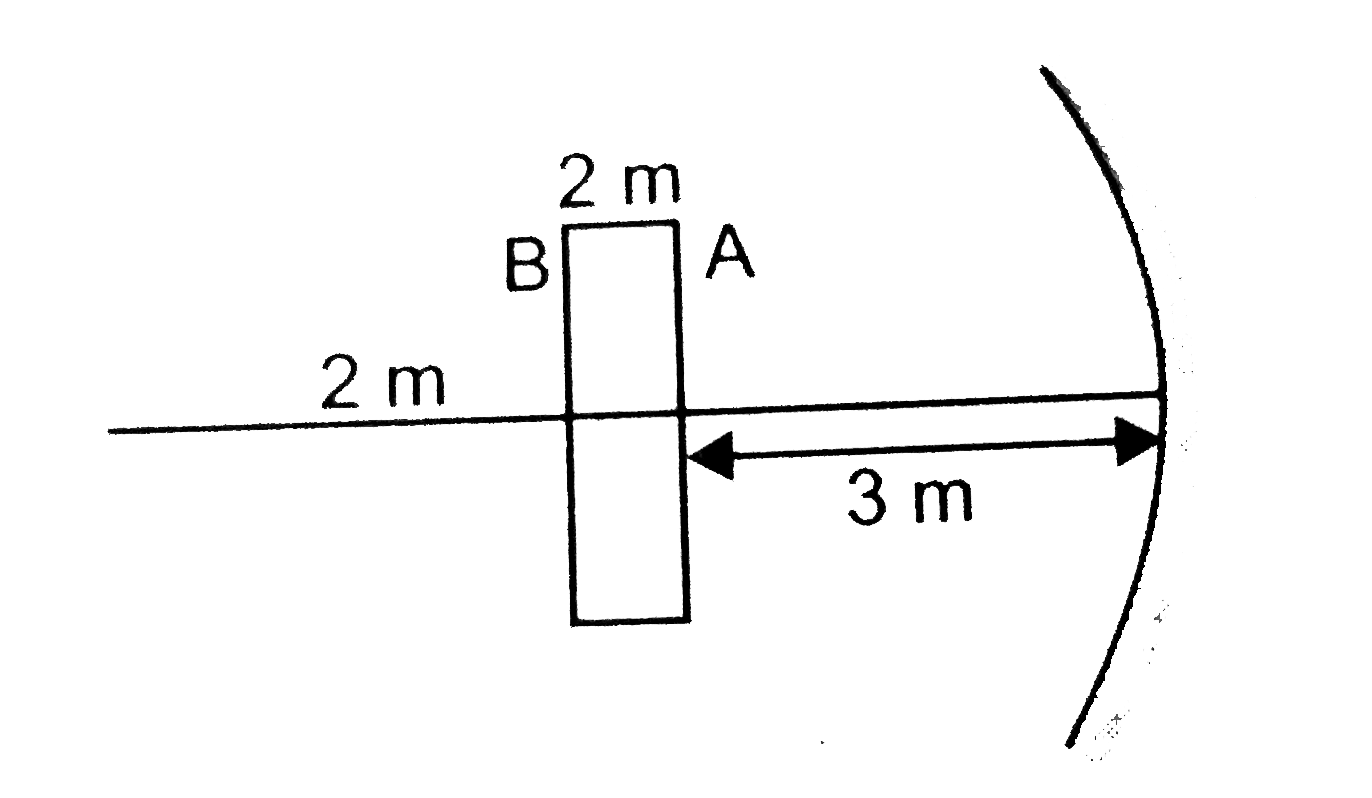
View SolutionAn object is placed at a distance `2f` from a concave mirror of focal length `f`. Light reflected from the mirror falls on a plane mirror. The distance of the plane mirror from the concave mirror equals `f`. The distance of the final image (due to reflection at both concave and plane mirror) from the concave mirror is
View SolutionA convergent beam of light converges to a point `20 cm` behind the convex mirror on the principal axis. An inverted image of the same size is formed coincident with the virtual object. Then, the focal length of the convex mirror is
View SolutionFor a concave mirror, if real image is formed the graph between `(1)/(u)` and `(1)/(v)` is of the form
View SolutionThe graph between `u` and `v` for a convex mirrorr is
View SolutionFor a concave mirrorr, if virtual image is formed, the graph between `m` and `u` is of the form
View SolutionA mark is made on the bottom of a vessel and over this mark, a glass slab to thickness `3.5 cm` and refractive index `(7)/(4)` is placed. Now water (refractive index, `(4)/(3))` is poured into the vessel so that the surface of water is `8 cm` above the upper surface of the slab. Looking down of normally through the water, the apparent depth of the mark below the surface of water will be `:`
View SolutionHow much water should be filled in a container of height `21 cm,` so that it appears half filled to the observer when viewed from the top of the container `(mu=4//3).`
View SolutionA beam of light is converging towards a point `I` on a screen. A plane glass plate whose thickness in the direction of the beam `=t` , refractive index `=mu` , is introduced in the path of the beam. The convergence point is shifted by
View SolutionThe image of point `P` when viewed from top of the slabs will be
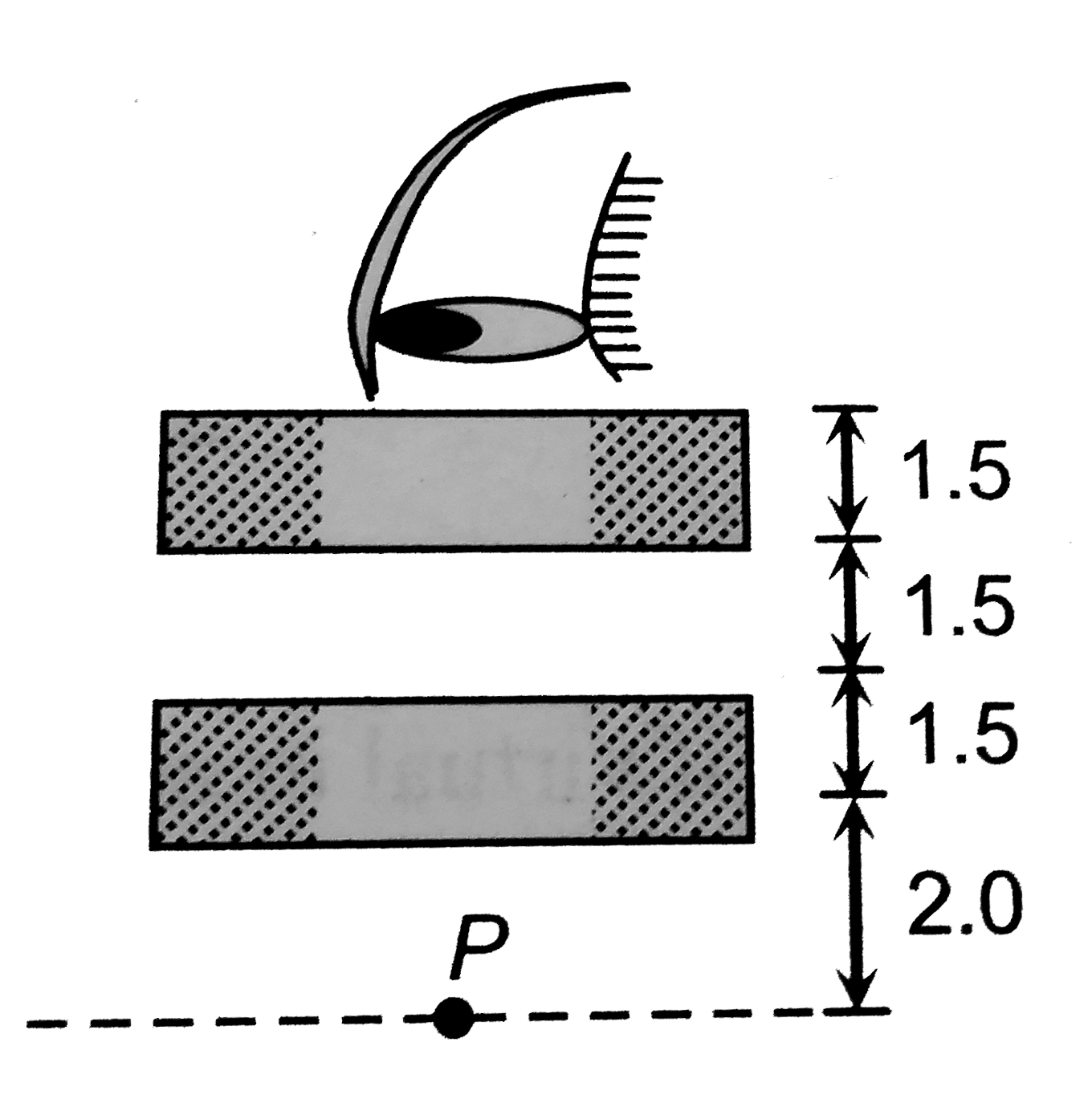
View SolutionThe length of the optical path of two media in contact of length `d_(1)` and `d_(2)` of refreactive indices `mu_(1)` and `mu_(2)` respectively, is
View SolutionWhen light travels from air to water and from water to glass, again from glass to `CO_(2)` gas and finally through air. The relation between their refractive indices will be given by
View SolutionA mark at the bottom of a liquid appears to rise by `0.1m`. The depth of the liquid is `1m`. The refractive index of the liquid is
View SolutionIf `hat(i)` denotes a unit vector along incident light ray, `hat (r)`a unit vector along refracted ray into a medium of refraction index `mu` and `hat (n)` unit vector normal to boundary of medium directed towards incident medium, then law of refraction is
View SolutionEach quarter of a vessel of depth `H` is filled with liquids of the refractive indices `n_(1),n_(2), n_(3)` and `n_(4)` from the bottom respectively. The apparent depth of the vessel when looked normally is
View SolutionRefractive index of air is `1.0003.` The correct thickness of air column which will have one more wavelength of yellow light `(6000 Å)` than in the same thickness in vacuum is
View SolutionA glass slab of thickness `3cm` and refractive index `3//2` is placed on ink mark on a piece of paper. For a person looking at the mark at a distance `5.0 cm` above it, the distance of the mark will appear to be
View SolutionA fish at a depth of `12 cm ` in water is viewed by an observer on the bank of a lake. To what height the images of the fish is raised ?
View Solution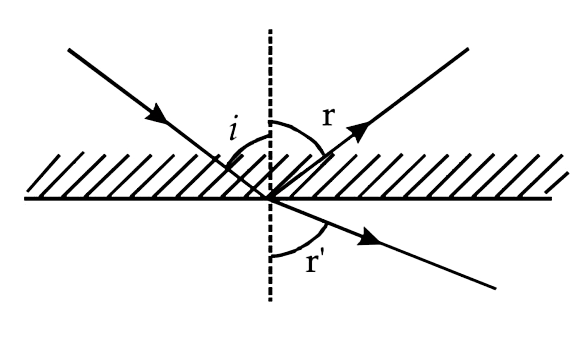
A ray of light from a denser medium strike a rarer medium at an angle of incidence I (see Fig). The reflected and refracted rays make as angle of 90degrees with each other. The angles of reflection and refraction are r and `r` The critical angle is
View SolutionA diver in a swimming poole wants to signal his distress to a person lying on the edge of the pool by flashing his water proof flash light
View SolutionA fish is a little away below the surface of a lake. If the critical angle is `49^(@)` , then the fish could see things above the water surface with in an angular range of `theta^(@)` where
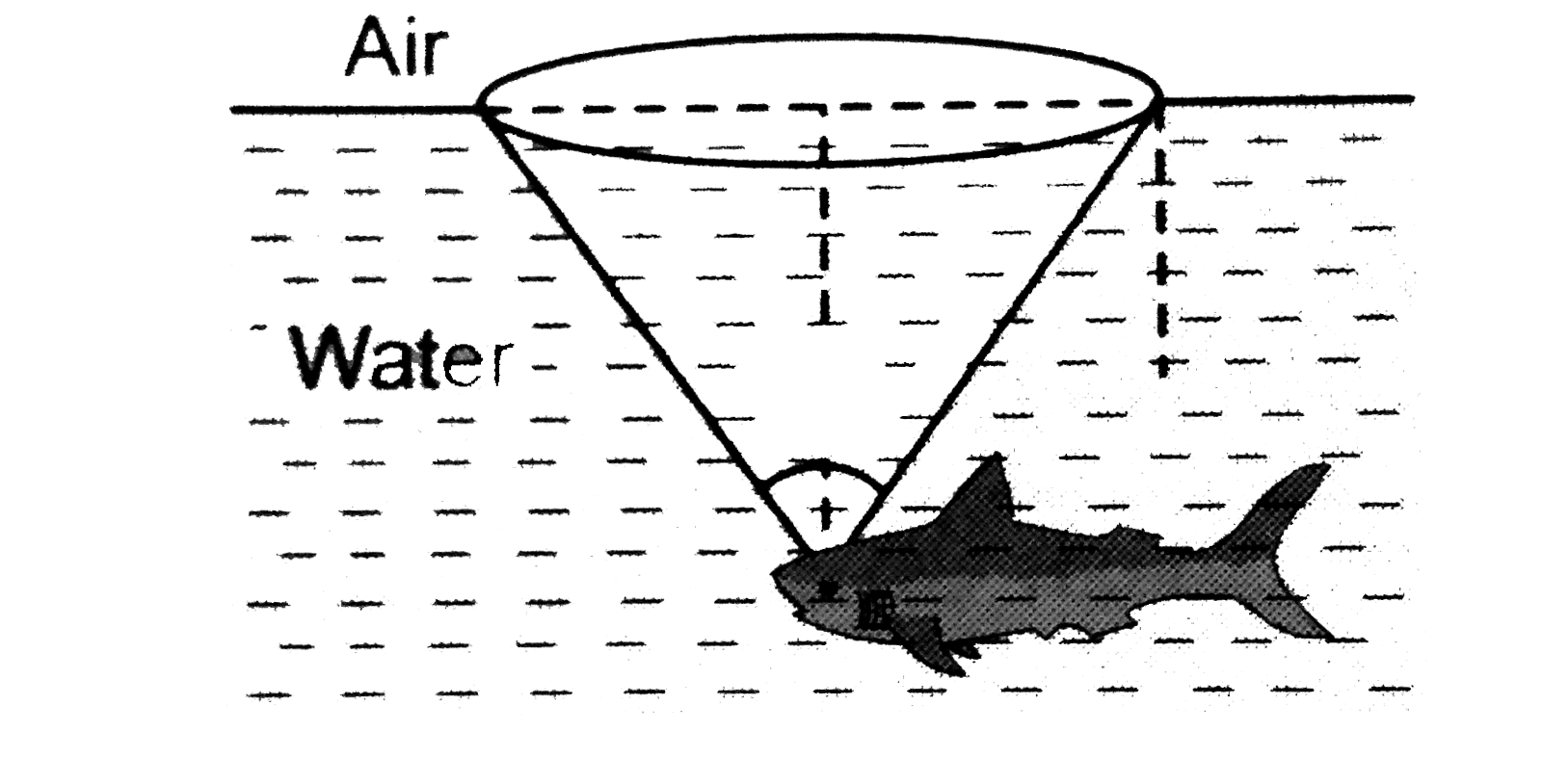
View SolutionFor total internal reflection to take place, the angle of incidence `i` and the refractive index `mu` of the medium must satisfy the inequality
View SolutionWith respect to air critical angle in a medium for light of red colour `[lambda_(1)]` is `theta`. Other facts remaining same, critical angle for light of yellow colour `[lambda_(2)]` will be
View SolutionThe velocity of light in a medium is half its velocity in air. If ray of light emerges from such a medium into air, the angle of incidence, at which it will be totally internally reflected, is
View SolutionA light ray from air is incident (as shown in figure ) at one end of a glass fiber ( refractive index `mu=1.5)` making an incidence angle of `60^(@)` on the lateral surface, so that it undergoes a total internal reflection. How much time would it take to traverse the straight fiber of length `1 km `?
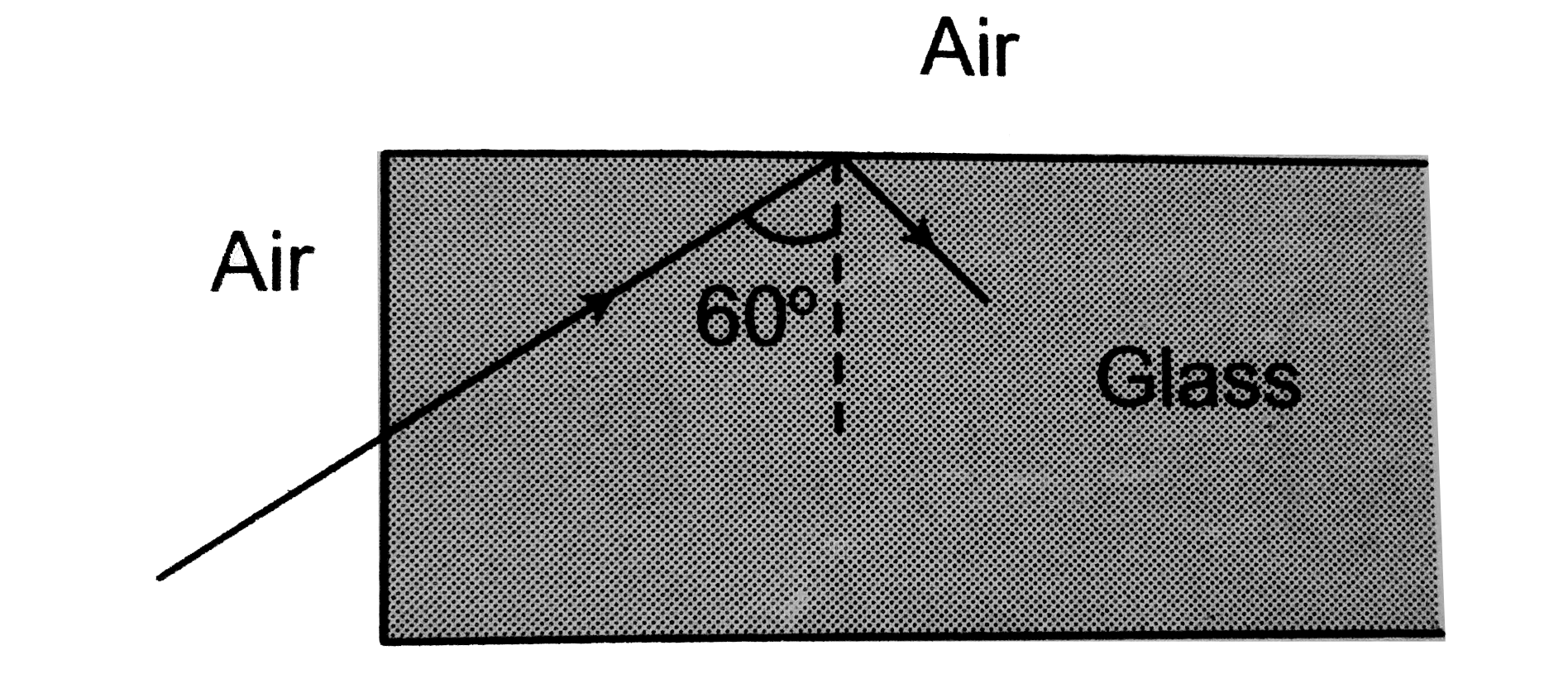
View SolutionLight wave enters from medium 1 to medium 2. Its velocity in `2^(nd)` medium is double from `1^(st)`. For total internal reflection, the angle of incidence must be greater than
View SolutionGlass has refractive index `mu` with respect to air and the critical angle for a ray of light going from glass to air is `theta`. If a ray of light is incident from air on the glass with angle of incidence `theta`, the corresponding angle of refraction is
View SolutionMaterial `A` has critical angle `i_(A)`, and material `B` has critical angle `i_(B)(i_(B)gti_(A))`. Then which of the following is true
(i) Light can be totally internally reflected when it passes from `B` to `A`
(ii) Light can be totally internally relected when it passes from `A` to `B`
(iii) Critical angle for total internal reflection is `i_(B)-i_(A)`
(iv) Critical angle between `A` and `B` is `sin^(-1)((sini_(A))/(sin i_(B)))`
View SolutionIn the figure shown , for an angle of incidence `45^(@)`, at the top surface , what is the minimum refractive index needed for the internal reflection at vertical face ?

View SolutionIf light travels a distance `x` in `t_(1)` sec in air and `10x` distance in `t_(2)` sec in a medium, the critical angle of the medium will be
View SolutionA ray of light passes from glass having a refractive index of `1.6,` to air. The angle of incidence for which the angle of refraction is twice the angle of incidence is
View SolutionA ray of light passes through four transparent media with refractive indices`mu_1`,`mu_2`,`mu_3` and `mu_4` as shown in the figure. The surfaces of all media are parallel. If the emergent ray CD is parallel to the incident ray AB, we must have
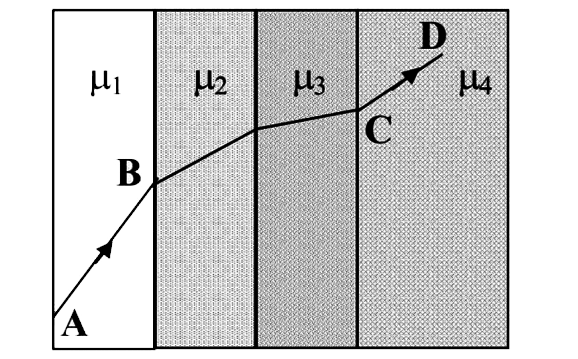
View SolutionA beam of white light is incident on glass air interface from glass to air such that green light just suffers total internal reflection. The colors of the light which will come out to air are
View SolutionA ray of light travels from a medium of refractive index `mu` to air. Its angle of incidence in the medium is `i`, measured from the normal to the boundary , and its angle of deviation is `delta. delta` is plotted against `i`. Which of the following best represents the resulting curve ?
View SolutionThe graph between sine of angle of refraction `(sin r)` in medium 2 and sine of angle of incidence `(sin i)` in medium indicates that `(tan 36^(@)~~(3)/(4))`
View Solution
Reflection Through Plain And Spherical Mirror questions and complete solutions for chapter GEOMETRICAL OPTICS of A2Z PHYSICS (HINGLISH) of Class 12